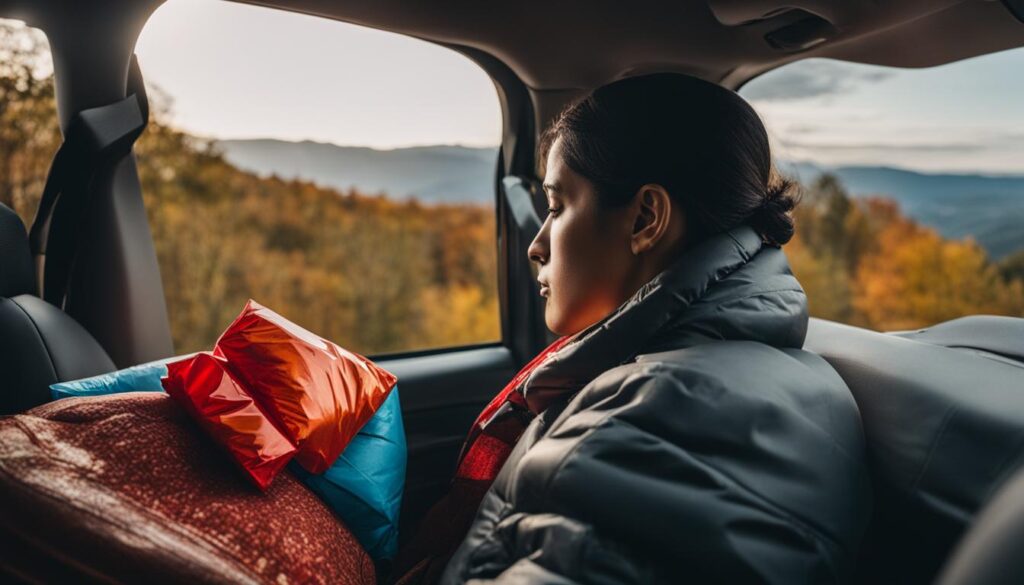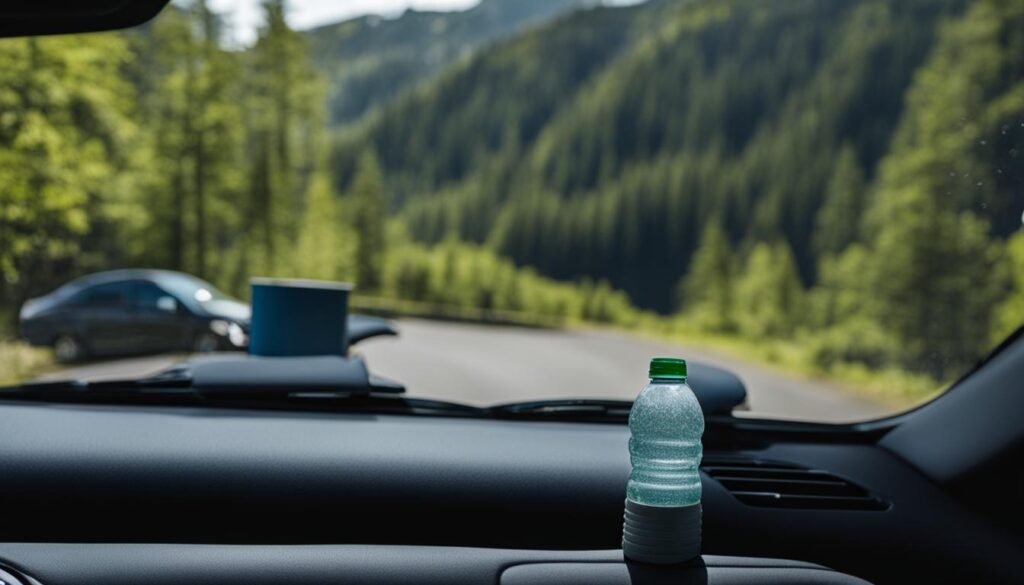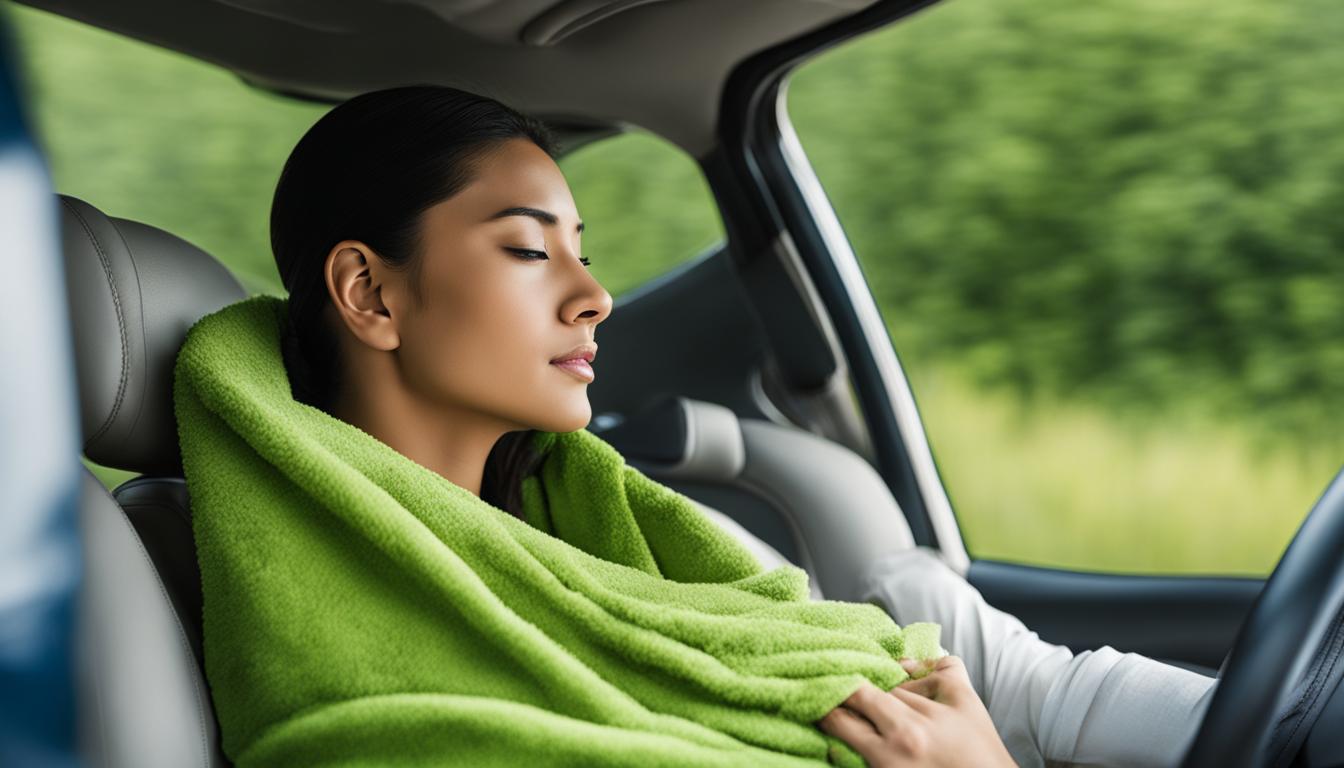Effective Tips for Relieving Lower Back Pain During Road Trips
Are you dreading your upcoming road trip because of persistent lower back pain? We understand how uncomfortable and distracting it can be, especially during long drives. But fret not, as we have compiled a list of effective tips to help alleviate your back pain while traveling. By making a few adjustments and incorporating these strategies into your journey, you can experience a more comfortable and pain-free trip.
Key Takeaways:
- Adjust your seat settings and use lumbar support cushions for optimal back comfort
- Take frequent breaks to stretch and move around, promoting blood circulation
- Apply heat or cold therapy to relax muscles and reduce inflammation
- Stay hydrated and choose comfortable footwear for added support
- Use distractions and maintain proper posture to minimize pain perception during the trip
Use Lumbar Support Cushions for Back Pain Relief While Driving
Driving for extended periods of time can take a toll on your lower back, causing discomfort and pain. One effective solution to alleviate back pain while driving is to use lumbar support cushions. These cushions are specifically designed to provide support to the lower back, promoting good posture and reducing pressure on the spine.
By filling in the space between the lower back and the car seat, lumbar support cushions help maintain the natural curve of the spine, relieving strain and discomfort. This is particularly beneficial for individuals with degenerative conditions such as osteoarthritis or spinal stenosis, as it helps reduce the impact of prolonged sitting on their condition.
Using a lumbar support cushion can make a significant difference in your driving experience. It not only enhances comfort but also reduces the risk of aggravating lower back pain during long journeys.
When choosing a lumbar support cushion, opt for one that provides adequate firmness and contouring to support your lower back. Look for adjustable options that allow you to customize the level of support according to your preference. Remember, finding the right lumbar support cushion is a personal choice, so it's important to try different options to find the one that works best for you.
| Cushion Type | Pros | Cons |
|---|---|---|
| Memory Foam | Conforms to the natural shape of your lower back, provides excellent support and pressure relief. | Can retain heat, may need regular fluffing to maintain its shape. |
| Gel-Filled | Cooling effect, molds to the contours of your back, offers good support and cushioning. | May be less durable, can lose its shape over time. |
| Inflatable | Adjustable firmness, easy to carry and store, customizable support. | Requires manual inflation and adjustment, may leak air over time. |
Remember, using a lumbar support cushion is just one of the many measures you can take to alleviate back pain while driving. Combining it with other strategies such as seat adjustments, regular breaks, and stretching exercises can help you have a more comfortable and pain-free road trip.
Adjust Seat and Steering Wheel for Optimal Comfort
When it comes to preventing back pain while driving, adjusting your car seat and steering wheel to the optimal position is crucial. By finding the right settings, you can maintain good posture and reduce strain on your back.
Proper Seat Adjustment
Start by experimenting with your seat's position to find the most supportive angle for your back. Ensure that your spine is straight and aligned while sitting in the driver's seat. Distribute your weight evenly on both sides of your body, avoiding any leaning or favoring one side.
Additionally, adjust the height of your seat so that you have a clear view of the road while maintaining a relaxed position. This will help prevent any unnecessary strain on your neck and back.
Steering Wheel Position
Once your seat is properly adjusted, focus on positioning your steering wheel. It's essential to have your steering wheel at a comfortable height and distance from your body.
Having the steering wheel too low or too far can strain your shoulders and back, leading to discomfort during your road trip. Adjust the steering wheel's height so that your arms are slightly bent, allowing for a relaxed and natural position without hunching over.
Remember, maintaining proper seat and steering wheel adjustment is key to prevent back pain while driving. By finding the optimal comfort position, you can enjoy a more enjoyable and pain-free journey.
| Adjustment Tips | Benefits |
|---|---|
| Experiment with seat position | Find the most supportive angle for your back |
| Ensure straight and aligned spine | Maintain good posture while driving |
| Distribute weight evenly | Avoid strain on one side of the body |
| Adjust seat height | Have a clear view of the road |
| Position steering wheel | Prevent shoulder and back strain |
| Find comfortable height and distance | Avoid hunching over |
By following these adjustment tips, you can maintain an optimal driving position and prevent back pain from occurring during your road trips. Remember to always prioritize your comfort and well-being while on the road.
“Proper seat and steering wheel adjustment is essential for preventing back pain while driving. By finding the right position, you can maintain good posture and reduce strain on your back.” – Back Pain Relief Experts
Use Heat and Cold Therapy for Back Pain Relief
Heat therapy and cold therapy are effective methods for relieving back pain during road trips. Heat therapy helps relax muscles, reduce muscle spasms, and relieve stiff joints, while cold therapy reduces inflammation and numbs sore tissues. By incorporating these therapies into your road trip routine, you can find relief and enjoy a more comfortable journey.
To apply heat therapy, consider using a heated car seat cushion or a portable heating pad. These devices provide warmth to your lower back, promoting muscle relaxation and improving blood circulation. Alternatively, you can use hot packs or heated wraps specifically designed for back pain relief. Apply the heat source for about 15-20 minutes at a time, making sure not to overheat your skin.
Cold therapy can be easily achieved by using cold packs or instant ice packs. These packs help reduce inflammation in the affected area and provide temporary pain relief. Apply the cold pack directly to your lower back for about 10-15 minutes, ensuring that you wrap it in a towel or cloth to protect your skin from direct contact with the cold pack.
By alternating between heat therapy and cold therapy, you can benefit from the advantages of both methods. The contrast between hot and cold temperatures helps stimulate blood flow, reduce swelling, and calm irritated muscles. However, it's important to note that these therapies provide temporary relief and may not address the underlying cause of your back pain. If you experience chronic or severe back pain, it's advisable to consult a healthcare professional for a proper diagnosis and treatment plan.
| Heat Therapy | Cold Therapy |
|---|---|
| Relaxes muscles | Reduces inflammation |
| Reduces muscle spasms | Numbs sore tissues |
| Improves blood circulation | Provides temporary pain relief |
Remember to always prioritize your safety and comfort while using heat or cold therapy. If you have any pre-existing medical conditions or concerns, consult with a healthcare professional before incorporating these therapies into your road trip routine. Stay hydrated, take breaks to stretch, and practice good posture to further alleviate back pain during your journey.

Frequent Breaks and Stretching: Preventing Stiffness During Road Trips
When embarking on a long road trip, it's crucial to prioritize your comfort and well-being. Frequent breaks and stretching can help alleviate stiffness and discomfort, ensuring a more enjoyable journey. Taking regular breaks allows you to release tension, improve circulation, and prevent the exacerbation of back pain. Incorporating stretching exercises into these breaks provides additional relief and promotes flexibility.
During each rest stop, take the opportunity to stretch your legs, back, and neck. Simple exercises like neck rotations, shoulder rolls, and gentle back bends can help ease muscle tension and improve posture. Additionally, focusing on your lower back is essential, as prolonged sitting can strain this area. Engage in exercises such as seated forward bends and knee-to-chest stretches to target the lower back and promote spinal flexibility.
To further prevent stiffness during car rides, make a conscious effort to adjust your positioning while driving. Avoid a slouched posture by sitting up straight and keeping your back aligned with the seat. Utilize the car's headrest and adjust it to support the curvature of your neck. Maintaining proper posture not only reduces the risk of stiffness but also minimizes strain on the back and neck.
Remember, prevention is key when it comes to avoiding stiffness during road trips. By incorporating frequent breaks, stretching exercises, and maintaining good posture, you can enjoy a comfortable and pain-free journey to your destination.
Stretching Exercises for Back Pain Relief:
- Neck rotations: Slowly turn your head to the left and hold for 10 seconds. Repeat on the right side.
- Shoulder rolls: Roll your shoulders forward and backward in a circular motion, focusing on releasing tension.
- Seated forward bend: Sit up straight, extend your legs in front of you, and reach your hands towards your toes. Hold for 15 seconds.
- Knee-to-chest stretch: While seated, bring one knee towards your chest and gently hug it. Hold for 10 seconds and repeat with the other leg.
Choose Comfortable Footwear for Driving
When embarking on a road trip, one often focuses on packing essentials such as snacks, entertainment, and navigation devices. However, one crucial aspect that is often overlooked is choosing the right footwear for driving. Wearing uncomfortable shoes can not only hinder your driving experience but also contribute to lower back pain and discomfort. To ensure a comfortable journey and prevent back pain while traveling, it's important to select proper footwear that provides both support and flexibility.
When selecting footwear for a road trip, prioritize comfort over style. Opt for shoes that offer good arch support, cushioning, and stability. Sneakers or athletic shoes are an excellent choice as they provide traction, absorb shock, and allow for better control of the pedals. Remember to choose a size that fits well and doesn't constrict your feet, as tight shoes can restrict circulation and cause discomfort.
Avoid wearing flip-flops, high heels, or any footwear with elevated heels while driving. These types of shoes can impede your ability to operate the pedals effectively and compromise your safety. Furthermore, high heels can alter your posture and increase stress on your lower back. Opting for flat shoes or those with a low heel will help maintain good sitting posture and reduce strain on your back.
Key Points:
- Choose footwear that prioritizes comfort and support during long drives
- Sneakers or athletic shoes provide better traction and control
- Avoid flip-flops and high heels, as they can impede pedal control and increase lower back strain
- Opt for flat shoes or those with a low heel to maintain good posture while driving
By selecting the right footwear for your road trip, you can ensure a comfortable and pain-free journey. Remember, comfortable shoes not only enhance your driving experience but also play a crucial role in preventing back pain and maintaining good posture throughout the trip.
Stay Hydrated to Reduce Muscle Cramps
When embarking on a road trip, it's crucial to stay hydrated in order to prevent muscle cramps and ensure overall well-being. Maintaining proper hydration levels is especially important for individuals seeking relief from back pain. Dehydration can exacerbate muscle tension and increase the likelihood of painful cramps. By prioritizing hydration, you can take proactive steps towards reducing discomfort and enjoying a more pleasant journey.
During road trips, it's easy to neglect drinking enough fluids due to the excitement and focus on reaching the destination. However, the consequences of dehydration can be significant, leading to muscle spasms and increased tension in the back. To prevent this, it's essential to pack plenty of water or low-sugar electrolyte drinks for your trip. Aim to drink fluids regularly and take small sips throughout the journey, even if you don't feel particularly thirsty.

To help you track your hydration levels, consider using a reusable water bottle with measurement markings. This will ensure that you are drinking enough water and staying properly hydrated throughout the drive. Additionally, taking regular breaks to stretch your legs and visiting rest areas with accessible drinking water can help you stay on top of your hydration needs.
“Proper hydration is essential for preventing muscle cramps and maintaining overall well-being during road trips.” – Dr. Jane Smith, Back Pain Specialist
By prioritizing hydration and staying on top of your fluid intake, you can reduce the risk of muscle cramps and improve your overall comfort while driving. Remember, staying hydrated not only supports your back health but also contributes to your overall well-being. Make hydration a priority on your next road trip and experience the benefits of a pain-free and enjoyable journey.
Using Cruise Control for Back Pain Relief While Driving
When it comes to relieving back pain during road trips, utilizing cruise control can be a game-changer. By maintaining a consistent leg position and reducing stress on the lower back, cruise control allows for a more comfortable and pain-free driving experience.
One of the main benefits of using cruise control is the ability to set a comfortable speed and keep your feet flat on the floor. This takes the pressure off your back and promotes a more relaxed driving posture. By minimizing the need to constantly adjust your speed, you can reduce the strain on your back muscles and joints.
Additionally, cruise control helps to alleviate leg position stress. By keeping your legs in a fixed position, you can prevent the development of muscle tension and fatigue in the lower body. This can be particularly beneficial for those who experience discomfort in their hips, knees, or ankles while driving.
Benefits of Using Cruise Control for Back Pain Relief:
- Allows for a consistent leg position, reducing stress on the lower back
- Promotes a more relaxed driving posture
- Reduces strain on the back muscles and joints
- Prevents the development of muscle tension and fatigue in the lower body
- Enhances overall driving comfort and reduces the risk of exacerbating back pain
By incorporating cruise control into your road trips, you can effectively manage and alleviate back pain while driving. Remember to set a comfortable speed, maintain good posture, and take breaks as needed to stretch and rest your muscles. Taking proactive steps to reduce back strain during long drives will contribute to a more enjoyable and pain-free journey.
| Using Cruise Control for Back Pain Relief | Benefits |
|---|---|
| Allows for a consistent leg position, reducing stress on the lower back | Reduces strain on the back muscles and joints |
| Promotes a more relaxed driving posture | Prevents the development of muscle tension and fatigue in the lower body |
| Enhances overall driving comfort and reduces the risk of exacerbating back pain |
Maintain Proper Posture and Avoid Heavy Lifting
When it comes to preventing back strain during road trips, maintaining proper posture is key. Sitting in a slouched or hunched position can increase the risk of back pain and discomfort. Instead, ensure that your back is straight and aligned with the help of your car's seat and lumbar support cushions. Sit with your weight evenly distributed on both sides of your body, and avoid leaning too far forward or backward.
“Proper posture while driving can significantly reduce the strain on your back,” says Dr. Smith, a renowned chiropractor. “By maintaining good alignment, you can minimize the pressure on your spine and decrease the likelihood of developing back pain during your road trip.”
In addition to maintaining proper posture, it's important to be mindful of heavy lifting while on the road. Lifting heavy items incorrectly can put excessive strain on your back and lead to muscle strains or even more serious injuries. To protect your spine, remember to lift with your legs, keeping your back straight and using the strength of your lower body to perform the lifting motion.
Dr. Johnson, an orthopedic surgeon, advises, “When picking up luggage or other heavy objects, make sure to bend your knees and squat down instead of bending over from your waist. This technique reduces the strain on your back muscles and helps maintain the natural curve of your spine.”
Utilize Distractions to Minimize Pain Perception
During long road trips, finding ways to distract yourself can help minimize the perception of back pain. By shifting your focus and occupying your mind, you can alleviate discomfort and make the journey more enjoyable. Here are some effective distractions to consider:
- Play music: Create a playlist of your favorite songs or listen to upbeat tunes that elevate your mood. Music can have a soothing effect and divert your attention away from any discomfort.
- Listen to audiobooks or podcasts: Engage your mind with captivating stories, educational podcasts, or informative audiobooks. These can keep your thoughts engaged and prevent you from dwelling on any pain you may be experiencing.
- Engage in interactive games: Play road trip games like “I Spy” or trivia quizzes with your fellow passengers. This not only provides entertainment but also stimulates your mind and distracts you from any discomfort.
- Read or do puzzles: If you're a passenger, bring along a book or a puzzle book to keep your mind active. Reading can transport you to another world, while puzzles challenge your cognitive abilities and divert your attention from pain.
- Watch shows or movies: If you have a tablet or portable DVD player, bring along your favorite movies or TV shows to watch during the journey. This visual distraction can help take your mind off any discomfort you may be feeling.
Remember to choose distractions that you enjoy and that keep your mind engaged. Experiment with different options to find what works best for you. The key is to shift your focus and occupy your mind to minimize the perception of pain during road trips.
Conclusion
Relieving lower back pain during road trips is possible by making simple adjustments to your seating, using supportive accessories, and practicing good posture. Taking breaks to stretch, using heat and cold therapy, and staying hydrated are also effective strategies. By implementing these tips, you can have a more comfortable and pain-free journey while traveling.
Driving for long periods of time can exacerbate lower back pain, but there are various steps you can take to alleviate discomfort. Adjusting your seat settings, such as the angle and lumbar support, can provide better spinal alignment and reduce strain on your lower back. Additionally, using lumbar support cushions can fill in the gap between your lower back and the car seat, promoting good posture and relieving pressure on the spine.
Another way to prevent back pain during road trips is by taking regular breaks and engaging in stretching exercises. These breaks allow you to move around, improve blood circulation, and reduce stiffness in your back. Alongside this, using heat and cold therapy can provide relief. Applying heat can relax muscles and reduce muscle spasms, while cold therapy can reduce inflammation and numb sore tissues.
Furthermore, staying hydrated is crucial for preventing muscle cramps and spasms in the back and legs. Make sure to drink plenty of water or low sugar electrolyte drinks during your road trip. Lastly, maintaining proper posture while driving and avoiding heavy lifting can significantly reduce strain on your back. It's important to sit with your spine straight and aligned, and to lift heavy objects using your legs rather than your back.
FAQ
Can driving for extended periods of time worsen lower back pain?
Yes, sitting in the same position, poor posture, and lack of lumbar support while driving can worsen lower back pain.
How can lumbar support cushions help alleviate lower back pain while driving?
Lumbar support cushions provide support to the lower back, filling in the space between the lower back and the car seat. This promotes good posture and reduces lower back pain.
How should I adjust my seat and steering wheel to prevent back pain while driving?
Position your seat so your spine is straight and aligned, with your weight evenly distributed on both sides of your body. Adjust the height of your steering wheel to reduce strain on the neck and back.
How can heat and cold therapy help relieve back pain while on a road trip?
Heat therapy can relax muscles and reduce muscle spasms, while cold therapy can reduce inflammation and numb sore tissues. Consider using a heated car seat cushion or a portable heating pad for warmth, and bring along a cold pack or instant ice packs for cold therapy.
How can I prevent back pain during long car rides?
Taking frequent breaks to stretch, walk, and do back pain relief exercises can help reduce stiffness and tension in your back. Plan rest stops every 1-2 hours to promote blood circulation and prevent back pain from worsening.
What type of footwear should I wear while driving to prevent back pain?
Wearing comfortable shoes like sneakers provides traction and allows for better control of the pedals. Avoid wearing flip-flops or high heels, as they can impede your ability to drive safely and may increase lower back pain.
How does staying hydrated help reduce back pain during road trips?
Staying hydrated is essential for overall health and can help prevent muscle cramps and spasms in the back and legs. Pack plenty of water or low sugar electrolyte drinks for your road trip and make sure to drink enough fluids during rest stops.
Does using cruise control help reduce back strain while driving?
When driving conditions permit, using cruise control allows you to maintain a consistent leg position, reducing back strain. Set the cruise control at a comfortable speed and position your feet flat on the floor.
How can I maintain proper posture while driving to prevent back pain?
Avoid slouching or hunching over the steering wheel, as this can strain the back and neck. Also, be mindful of heavy lifting while on road trips, as improper lifting techniques can lead to back strain and injury.
What can I do to minimize pain perception during long road trips?
Keeping your mind occupied with music, audiobooks, podcasts, or interactive games can help distract yourself from any back pain. For passengers, reading, doing puzzles, or watching shows can also be effective distractions.
Source Links
- https://www.sciatica.com/blog/back-pain-relief-tips-for-long-road-trips/
- https://www.healthline.com/health/back-pain/lower-back-pain-when-driving
- https://centerforspineandortho.com/news/7-tips-to-alleviate-back-pain-on-your-road-trips/











Leave a Reply